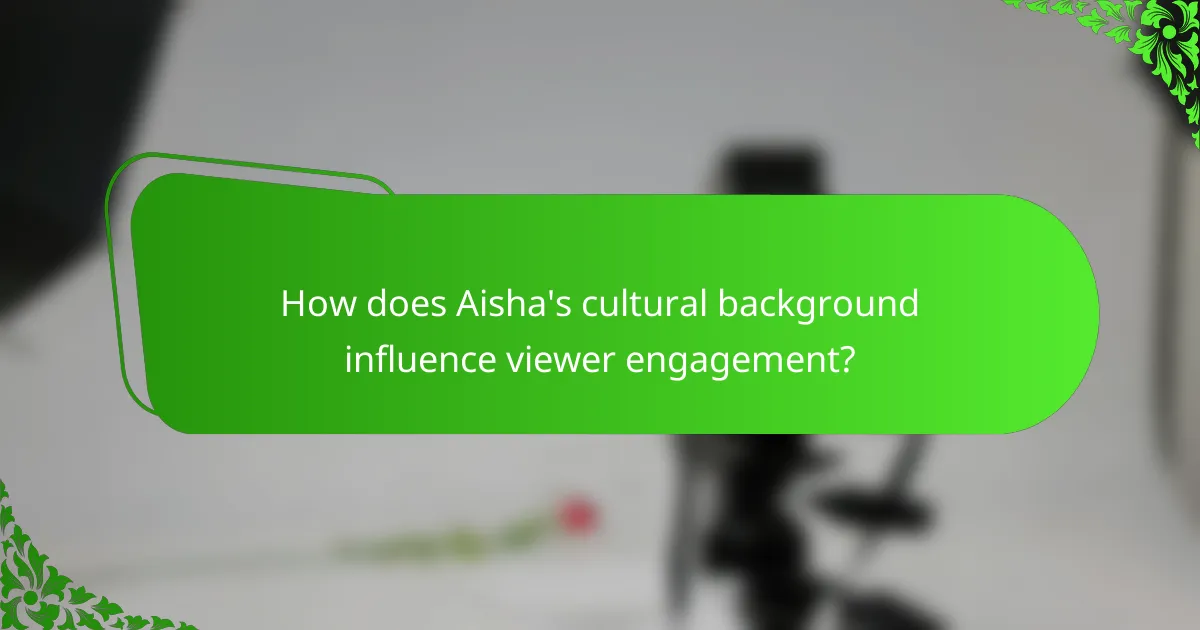Aisha offers a unique exploration of cultural narratives that resonate with a diverse audience, enhancing viewer engagement through relatable themes. While opinions on the show vary, many viewers express strong emotional connections to its characters and storylines, highlighting its impact in the genre. The blend of humor and cultural identity makes Aisha a standout series, inviting both appreciation and critique from its audience.

How does Aisha’s cultural background influence viewer engagement?
Aisha’s cultural background significantly shapes viewer engagement by providing relatable themes and narratives that resonate with diverse audiences. This connection fosters a deeper emotional investment, enhancing the overall viewing experience.
Influence of cultural themes
Cultural themes in Aisha often reflect traditional values, social norms, and contemporary issues that resonate with viewers. These themes can include family dynamics, community bonds, and the struggles of identity, which are familiar to many audiences.
For instance, storylines that explore the balance between modernity and tradition can engage viewers by prompting them to reflect on their own experiences. This relatability can lead to increased discussions and sharing among viewers, enhancing engagement.
Representation of diverse communities
Aisha’s portrayal of diverse communities allows viewers from various backgrounds to see themselves represented on screen. This representation is crucial for fostering inclusivity and encouraging viewers to connect with the characters and their journeys.
By showcasing a range of cultural perspectives, Aisha not only broadens its appeal but also invites dialogue about different experiences and challenges. This can lead to a more engaged audience that feels valued and heard.
Impact on storytelling
The cultural background of Aisha influences its storytelling techniques, often incorporating elements like folklore, music, and language that enrich the narrative. These aspects can create a unique storytelling style that captivates audiences and sets the show apart.
Moreover, culturally informed storytelling can enhance emotional depth, making characters’ journeys more impactful. Viewers are likely to engage more deeply when they encounter stories that reflect their realities or challenge their perceptions.

What are viewer opinions on Aisha?
Viewer opinions on Aisha vary widely, reflecting a mix of appreciation and criticism. Many viewers express strong emotional connections to the character and storyline, while others raise concerns about certain aspects of the show.
Positive audience feedback
Many viewers praise Aisha for its rich storytelling and character development. Fans often highlight the relatable struggles faced by Aisha, which resonate with their own experiences, fostering a sense of connection.
The visual aesthetics and production quality also receive commendations, with audiences noting the vibrant cinematography and engaging soundtrack that enhance the viewing experience. This combination of elements contributes to a loyal fanbase that actively engages with the content through social media and fan discussions.
Critiques and concerns
Despite the positive feedback, some viewers express critiques regarding pacing and plot consistency. Certain episodes are perceived as dragging, leading to frustration among audiences who prefer a more dynamic narrative flow.
Additionally, concerns about character representation and development have been voiced. Some viewers feel that certain characters lack depth or that their arcs do not align with the overall themes of the show, prompting discussions about inclusivity and authenticity in storytelling.

How does Aisha compare to similar shows?
Aisha stands out among similar shows by blending cultural narratives with humor and relatable experiences. Its unique perspective on identity and belonging resonates with audiences, making it a notable entry in the genre.
Comparison with ‘Ramy’
Aisha and ‘Ramy’ both explore the complexities of cultural identity within the context of American society. While ‘Ramy’ focuses on a first-generation Muslim American’s struggles with faith and family, Aisha delves into the experiences of a South Asian woman navigating her cultural heritage and modern life.
Both shows utilize humor to address serious themes, but Aisha leans more towards a female-centric viewpoint, highlighting issues such as gender roles and societal expectations. This distinction allows Aisha to carve out its own niche in the landscape of culturally themed television.
Comparison with ‘Master of None’
However, Aisha emphasizes the female perspective more prominently, showcasing the unique hurdles women face in balancing tradition and modernity. This focus on female experiences provides a fresh angle compared to the more general approach of ‘Master of None’, which often centers on male experiences.

What are the key engagement metrics for Aisha?
The key engagement metrics for Aisha include viewership statistics and social media interactions, which provide insights into audience reach and participation. Understanding these metrics helps gauge the show’s popularity and viewer connection.
Viewership statistics
Viewership statistics for Aisha typically encompass total viewers, average watch time, and demographic breakdowns. For instance, shows in this genre often attract low tens of thousands to hundreds of thousands of viewers per episode, depending on the platform and time slot.
Monitoring trends in viewership can reveal patterns, such as peak viewing times or episodes that resonate more with specific demographics. This data is crucial for content creators to tailor future episodes to audience preferences.
Social media interactions
Social media interactions include likes, shares, comments, and overall engagement rates across platforms like Twitter, Instagram, and Facebook. Aisha’s social media presence may generate hundreds to thousands of interactions per post, reflecting viewer enthusiasm and participation.
Engagement on social media can amplify the show’s reach, as viewers share their thoughts and experiences. Encouraging audience interaction through polls or Q&A sessions can further enhance community involvement and loyalty.

What cultural themes are explored in Aisha?
Aisha delves into various cultural themes, prominently focusing on identity, belonging, and family dynamics. These themes reflect the complexities of navigating cultural expectations and personal relationships within a specific societal context.
Identity and belonging
The theme of identity and belonging in Aisha highlights the struggle individuals face in reconciling their cultural heritage with their personal experiences. Characters often grapple with societal expectations that shape their sense of self, leading to moments of introspection and conflict.
For instance, a character may feel pressure to conform to traditional roles while simultaneously seeking to assert their individuality. This duality can create tension, prompting viewers to reflect on their own experiences of identity within their cultural frameworks.
Family dynamics
Family dynamics play a crucial role in Aisha, showcasing how relationships within families can influence personal growth and cultural understanding. The interactions between family members often reveal underlying tensions that stem from differing values and generational gaps.
In many scenes, conflicts arise from expectations placed on younger generations by their elders, illustrating the challenges of maintaining familial bonds while pursuing personal aspirations. This theme resonates with viewers who may recognize similar patterns in their own family structures.

What are the challenges faced by Aisha in the media landscape?
Aisha faces several challenges in the media landscape, including representation issues and intense market competition. These factors significantly impact her visibility and the audience’s perception of her work.
Representation issues
Representation issues in media can lead to stereotypes and misinterpretations of Aisha’s cultural background. When diverse voices are underrepresented, it can create a narrow narrative that fails to capture the richness of her experiences.
To address these challenges, media creators should strive for authentic storytelling that reflects Aisha’s true identity. This involves engaging with her community and ensuring that her perspectives are accurately portrayed.
Market competition
The media landscape is highly competitive, with numerous creators vying for audience attention. Aisha must navigate this crowded space, where visibility can be limited by algorithm-driven platforms and shifting viewer preferences.
To stand out, Aisha can focus on niche content that resonates with her target audience. Building a strong personal brand and leveraging social media can enhance her engagement and help her connect with viewers who appreciate her unique voice.

How does Aisha foster community engagement?
Aisha fosters community engagement by creating inclusive platforms for dialogue and collaboration among viewers. This approach encourages active participation and strengthens connections within diverse cultural backgrounds.
Viewer forums and discussions
Aisha hosts viewer forums and discussions that allow participants to share their thoughts and experiences related to the content. These platforms often feature moderated discussions, ensuring respectful dialogue and a safe space for all voices.
Engagement in these forums can lead to deeper understanding and appreciation of various cultural perspectives. Regularly scheduled discussions can help maintain momentum and encourage ongoing participation.
Collaborations with cultural organizations
Aisha collaborates with cultural organizations to enhance community engagement through shared events and initiatives. These partnerships often include workshops, exhibitions, and cultural festivals that celebrate diversity and promote intercultural dialogue.
By working with established organizations, Aisha can leverage resources and expertise, creating richer experiences for viewers. Such collaborations also help reach broader audiences, fostering a sense of belonging and community involvement.

What are the emerging trends in cultural representation in media?
Emerging trends in cultural representation in media focus on inclusivity, authenticity, and diversity. These trends aim to reflect a broader spectrum of identities and experiences, moving away from stereotypes and towards more nuanced portrayals.
Increased Diversity in Storytelling
Increased diversity in storytelling is evident as creators strive to include a wider range of voices and perspectives. This shift allows for richer narratives that resonate with diverse audiences, fostering a sense of belonging. For example, films and series featuring characters from various ethnic backgrounds or those with disabilities are becoming more common.
Authenticity in Representation
Authenticity in representation emphasizes the importance of accurate portrayals of cultures and communities. This trend encourages creators to engage with cultural consultants and individuals from the represented communities to ensure genuine depictions. For instance, hiring actors from specific cultural backgrounds can enhance the credibility of the narrative.
Audience Engagement and Feedback
Audience engagement and feedback play a crucial role in shaping cultural representation in media. Viewers increasingly express their opinions through social media and online platforms, influencing production decisions. Creators are now more attentive to audience reactions, leading to adjustments in storylines or character development based on viewer preferences.










